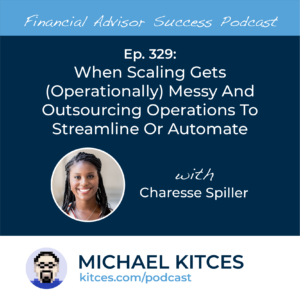 Welcome back to the 329th episode of the Financial Advisor Success Podcast!
Welcome back to the 329th episode of the Financial Advisor Success Podcast!
My guest on today's podcast is Charesse Spiller. Charesse is Founder and Principal Consultant for Level Best, an operations and process strategy consulting firm based in Houston, Texas.
What's unique about Charesse though, is how she has founded a consulting firm that doesn’t just try to teach financial advisors how to systematize and automate, and instead actually works as an outsourced provider to build and implement those systems… with a goal of working themselves out of a job over 6 to 12 months so the advisory firm can once again run on its own (but now, in a far more streamlined and efficient process).
In this episode, we talk in-depth about how Charesse developed her approach of not only evaluating an advisory firm’s technology, but also their processes and systems, and incorporates the importance of training the firms’ teams to implement best practices within their existing system, how Charesse defines her 3 pillars of operations including streamlining (which is all about creating an efficient repeatable process), automation (which is about leveraging technology to not just streamline a task but make automate it away altogether), and delegation (for that subset of tasks that can’t feasibly be automated, but could still be trained and handed off to another team member to free up the advisor’s time), and how Charesse developed her own 3 tiers of service from consulting with advisors about the tech they could be using, to working with advisors to build their workflows and process maps within the firm, to helping firms actually implement their new workflows and processes in their technology (and train their teams to actually use the tech and follow the new processes!).
We also talk about how Charesse discovered that for larger RIAs the real blocking point in scaling is often not whether the firm has developed systems and processes but a lack of clear accountability about which team member is responsible for each step of the process as the firm grows, why Charesse decided to create an educational resource and community called FinOps Co-op to further educate operations professionals on how they can optimize their systems and processes on an ongoing basis, and how Charesse realized that even though she was helping others optimize their time and businesses, she needed to help herself as a founder of a consulting firm and hired a financial coach to get her more centered and steer away from possible burnout.
And be certain to listen to the end, where Charesse shares how she’s lived first-hand the challenge that all service firms face as they begin to scale up with staff and have to revisit and increase their pricing to be able to afford to scale up, how she decided to go from an employee in an advisory firm to a freelancer supporting advisory firms to an all-in founder of a consulting firm for advisors, and how Charesse has combined reading business books, leveraging local mentoring programs, and forming 2 Mastermind groups for herself to level up her own marketing, sales, and leadership skills as she and her business grew.
So, whether you’re interested in learning about how Charesse helps advisory firms create better processes and follow through on implementation, how Charesse is helping to further educate operations professionals on best practices through her FinOps Co-op, or why Charesse offers additional consulting services to advisory firms as they scale so that their processes evolve as the firm evolves, then we hope you enjoy this episode of the Financial Advisor Success podcast, with Charesse Spiller.








